The NVIDIA Turing GPU Architecture Deep Dive: Prelude to GeForce RTX
by Nate Oh on September 14, 2018 12:30 PM ESTRay Tracing 101: What It Is & Why NVIDIA Is Betting On It
Because one of the two cornerstone technologies of the Turing architecture is NVIDIA’s ray tracing RT cores, before we dive too much into the Turing architecture, it’s perhaps best to start with a discussion on just what ray tracing is. And equally important, why NVIDIA is betting so much silicon on it.
Ray tracing, in short, is a rendering process that emulates how light behaves in the real world. From a fundamental (but not quite quantum physics) level, light can be considered to behave like a ray. This is because photons, outside other influences, will travel in a straight line until they hit something. At which point various interactions (reflection, refraction, etc) occur between photons and the object.
The catch with ray tracing is that it’s expensive. Incredibly expensive. The scale of the problem means that if you take a naïve approach and try to calculate all of the rays of photons emitting from every light source in a scene, you’re going to be tracing an uncountable, near-infinite number of rays bouncing around a scene. It is essentially modeling all of the physical interactions of light within a bounded space, and that’s an incredible number of interactions.
As a result there have been a number of optimizations developed for ray tracing over the years. Perhaps the most important of which is sort of turning the naïve concept on its head, and instead of tracing rays starting from light sources, you instead go backwards. You trace rays starting from the point of the observer – essentially casting them out into a scene – so that you only end up calculating the light rays that actually reach the camera.
Such “reverse” ray tracing cuts down on the problem space significantly. It also means that conceptually, ray tracing can be thought of as a pixel-based method; the goal is to figure out what each pixel should be.
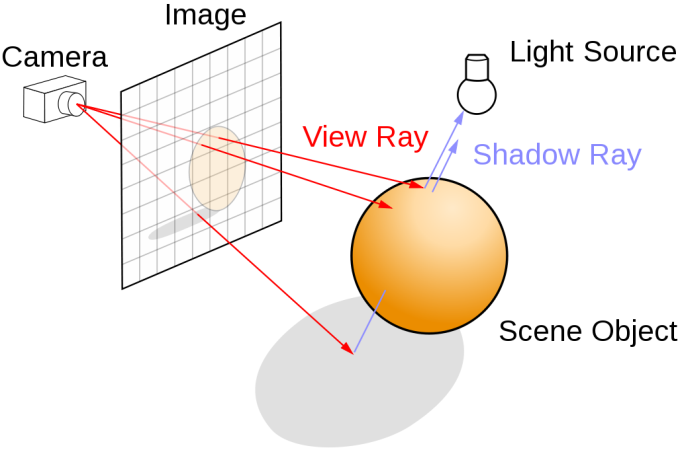
Ray Tracing Diagram (Henrik / CC BY-SA 4.0)
However even with this optimization and others, ray tracing is still very expensive. These techniques make ray tracing cheap enough that it can be done on a computer in a reasonable amount of time, where “reasonable” is measured in minutes or hours, depending on the scene and just how precise and clean you want the rendered frame to be. As a result, anything other than the cheapest, grainiest ray tracing has been beyond the reach of real-time rendering.
In practical terms then, up until now ray tracing has been reserved purely for “offline” scenarios, particularly 3D graphics in movies. The quality of ray tracing makes it second to none – it’s emulating how light actually works, after all – as it can accurately calculate reflections, shadows, light diffusion, and other effects to a degree of accuracy that no other method can. But doing all of this comes at a heavy cost.
Enter Rasterization: The World’s Greatest Hack
The high computational cost of ray tracing means that it hasn’t been viable for real-time graphics. Instead, since the earliest of days, the computing industry has turned to rasterization.
If ray tracing is a pixel-based approach, then rasterization would be called a polygon-centric approach to 3D rendering. But more than that, rasterization is a hack – a glorious hack to get around the fact that computers aren’t (or at least, weren’t) fast enough to do real-time ray tracing. Rasterization takes a number of shortcuts and makes a number of assumptions about how light, objects, and materials work in order to reduce the computational workload for rendering a scene down to something that can be done in real time.
Rasterization at its most basic level is the process of taking the polygons in a scene and mapping them to a 2D plane, the pixel grid. This means polygons are sorted and tested to see which polygons are actually visible, and then in various stages, these polygons are textured, shaded, and otherwise processed to determine their final color. And admittedly this is a gross simplification of a process that was already a simplification – I’m completely ignoring all the math that goes into transforming 3D objects into a 2D representation – but in an amusing twist of fate, the hack that is rasterization is in some ways more complex than the natural process of ray tracing.
The key point to rasterization is not so much how it works, but rather that it doesn’t use rays, and therefore it’s cheap. Very cheap. And better still, it can be done in parallel. As a result GPUs have arisen as incredible matrix multiplication machines, and are capable of testing hundreds of millions of polygons every second and coloring billions of pixels. With a few exceptions, rasterization is nice and orderly, allowing computational techniques like Single Instruction Multiple Data/Thread (SIMD/SIMT) to do the necessary processing with incredible efficiency.
The catch to rasterization is that because it’s a hack – however glorious it is – at the end of the day there are limitations to how well it can fake how vision and light work in the real world. Past basic polygon projection and texturing, pixel shading is where most of the work is done these days to actually determine what color a pixel needs to be. It’s in pixel shaders that the various forms of lighting (shadows, reflection, refraction, etc) are emulated, where distortion effects are calculated, etc. And pixel shaders, while powerful in their own right, are not capable of emulating real light to a high degree, at least not in a performant manner.
It’s these limitations that lead to the well-publicized drawbacks in rasterization. The unnatural light, the limited reflections, the low resolution shadows, etc. Now conceptually, it is by no means impossible to resolve these issues with rasterization. However the computational cost of doing so is very high, as the nature of rasterization is such that it’s difficult to bolt on such high accuracy methods on to what’s at its core a hack. Rasterization is meant to be quick & dirty, not accurate.
Ray Tracing Returns – Hybridization
Coming full-circle then, we reach the obvious question: if rasterization is so inaccurate, how are games meant to further improve their image quality? Certainly it’s possible to continue going down the road of rasterization, and even if the problem gets harder, image quality will get better. But keeping in mind that rasterization is a hack, it’s good to periodically look at what that hack is trying to achieve and whether that hack is worth the trade-offs.
Or to put this another way: if you’re going to put in this much effort just to cheat, maybe it would be better to put that effort into accurately rendering a scene to begin with?
Now in 2018, the computing industry as a whole is starting to ask just that question. Ray tracing is still expensive, but then so are highly accurate rasterization methods. So at some point it may make more sense to just do ray tracing at certain points rather than to hack it. And it’s this train of thought that NVIDIA is pursuing with great gusto for Turing.
For NVIDIA, the path forward is no longer pure rasterization. Instead their world view is one of hybrid rendering: combining the best parts of rasterization and compute with the best parts of ray tracing. Just what those parts are and where they should be done is a question ultimately up to developers, but at a high level, the idea NVIDIA is putting forth is to use ray tracing where it makes sense – for lighting, shadows, and everything else involving the interaction of light – and then using traditional rasterization-based methods for everything else.
This means that rather than immediately jumping from rasterization to ray tracing and losing all of the performance benefits of the former, developers can enjoy the best of both worlds, choosing how they want to balance the performance of rasterization with the quality of ray tracing. The examples NVIDIA and its partners have pitched thus far have been the low-hanging fruit – accurate real-time reflections, improved transparency, and better global illumination – but the use cases conceivably be extended to any kind of lighting-related operation. And perhaps, for the John Carmacks and Tim Sweeneys of the world, possibly something a lot more unorthodox.
With all of that said however, just because hybrid rasterization and ray tracing looks like a good idea on paper, that doesn’t mean it’s guaranteed to work well in practice. Certainly this initiative spans far more than just NVIDIA – Microsoft’s DXR API is a cornerstone that everyone can build from – however to call this the early days would be an overstatement. NVIDIA, Microsoft, and other companies are going to have to build an ecosystem essentially from scratch. And they’re not only going to have to sell developers on the merits of ray tracing, but they’re going to have to teach developers on how to implement it in an efficient manner. Neither of these are easy tasks. After all, ray tracing is not the only way forward, it’s merely one way forward. And, if you agree with NVIDIA, the most promising way forward.
But for today, let’s table the discussion of the merits of ray tracing. NVIDIA has made their move, and indeed the decisions that lead to Turing would have happened years ago. So instead, let’s take a look at how NVIDIA is going to transform their goals into reality by building hardware units specifically for ray tracing.


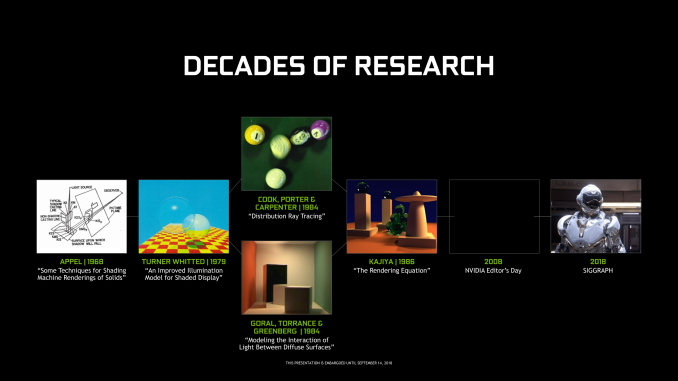
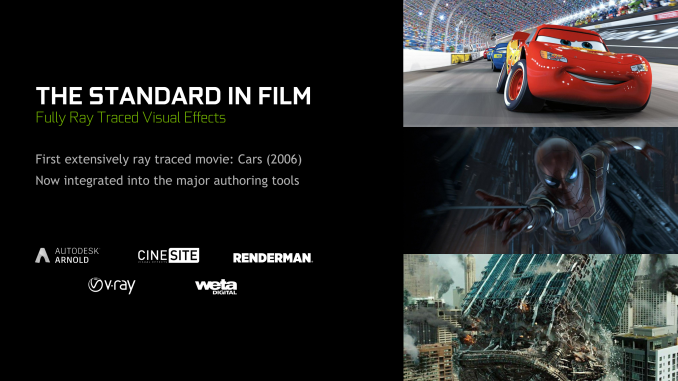
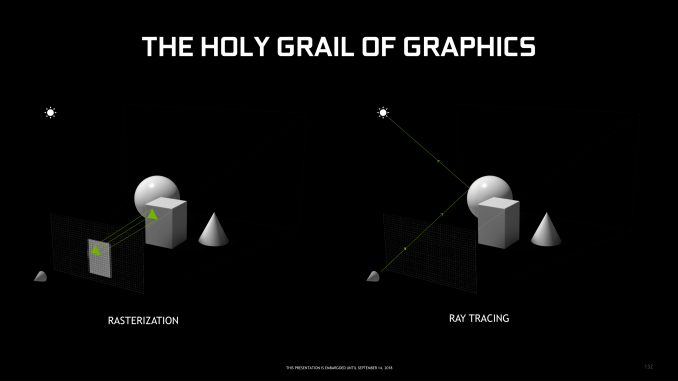
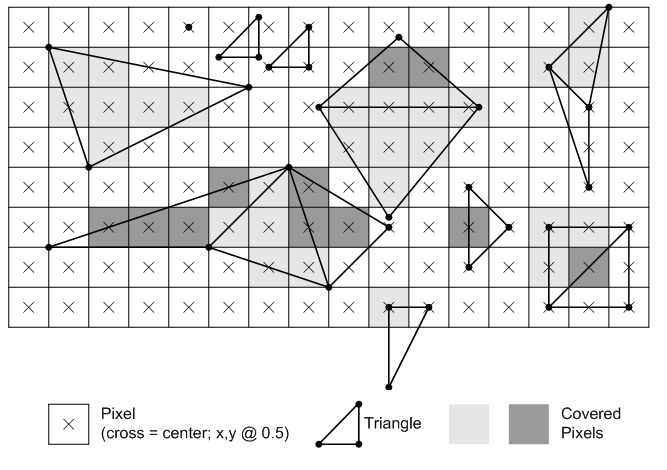
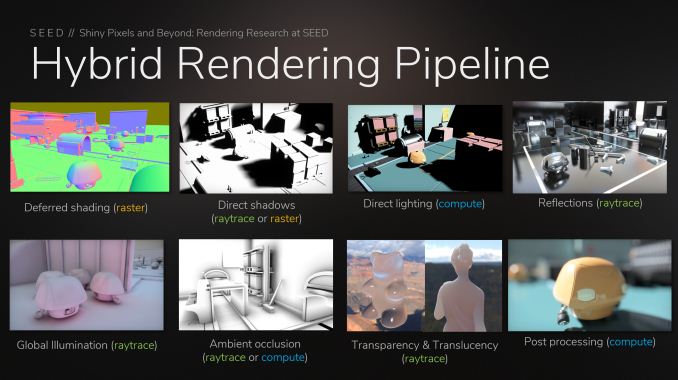








111 Comments
View All Comments
willis936 - Sunday, September 16, 2018 - link
Also in case there's anyone else in the signal integrity business reading this: does it bug anyone else that eye diagrams are always heatmaps without a colorbar legend? When I make eye diagrams I put a colorbar legend in to signify hits per mV*ps area. The only thing I see T&M companies do is specify how many samples are in the eye diagram but I don't think that's enough for easy apples to apples comparisons.Manch - Sunday, September 16, 2018 - link
No, bc heatmaps are std.willis936 - Monday, September 17, 2018 - link
A heatmap would still be used. The color alone has no meaning unless you know how many hits there are total. Even that is useless if you want to build a bathtub. The colorbar would actually tell you how many hits are in a region. This applies to all heatmaps.casperes1996 - Sunday, September 16, 2018 - link
Wow... I just started a computer science education recently, and I was recently tasked with implementing an effecient search algorithm that works on infinitely long data streams. I made it so it first checks for an upper boundary in the array, (and updates the lower boundary based on the upper one) and then does a binary search on that subarray. I feel like there's no better time to read this article since it talks about the BVH. I felt so clever when I read it and thought "That sounds a lot like a binary search" before the article then mentioned it itself!ballsystemlord - Sunday, September 16, 2018 - link
You made only 1 typo! Great job!"In any case, as most silicon design firms hvae leapfrogging design teams,"
Should be "have":
"In any case, as most silicon design firms have leapfrogging design teams,"
There is one more problem (stray 2 letter word), in your article, but I forgot were it was. Sorry.
Sherlock - Monday, September 17, 2018 - link
The fact that Microsoft has released a Ray Tracing specific API seems to suggest that the next XBox will support it. And considering AMD is the CPU/GPU partner for the next gen XBox - it seems highly likely that the next gen AMD GPU's will have dedicated Ray Tracing hardware as well. I expect meaningful use of these hardware feature only once the next gen console hardware is released - which is due in the next 2-3 years. RTX seems a wasteful expenditure for the end-consumer now. The only motivation for NVidia to release this now is so that consumers don't feel as they are behind the curve against AMD. This gives some semblance to the rumros that Nvidia will release a "GTX" line and expect it to be their volume selling product - with the RTX as proof-of-concept for early adoptersbebby - Monday, September 17, 2018 - link
Very good point from Sherlock. I also believe that Sony and Microsoft will be the ones defining what kind of hardware features will be used and which not.In general, with Moore's Law slowing down, progress gets slower and the incremental improvements are minimal. With the result that there is less competition, prices go up and there is not any more any "wow" effect coming with a new GPU. (last time I had this was with the 470gtx)
My disappointment lies with the power consumption. Nvidia should focus more on power consumption rather than performance if they ever want to have a decent market share in tablets/phablets.
levizx - Monday, September 17, 2018 - link
Actually the efficiency increased only 18% not 23%. 150% / 127% - 1 = 18.11%, you can't just 50% - 27% = 23%, the efficiency increase is compared to "without optimization" i.e. 127%rrinker - Monday, September 17, 2018 - link
91 comments (as I type this) and most of them are arguing over "boo hoo, it's too expensive" Well, if it's too expensive - don't buy it. Why complain? Oh yeah, because Internet. This is NOT just the same old GPU, just a little faster - this is something completely different, or at least, something with significant differences to the current cop of traditional GPUs. There's no surprise that it's going to be more expensive - if you are shocked at the price then you really MUST be living under a rock. The first new ANYTHING is always premium priced - there is no competition, it's a unique product, and there is a lot of development costs involved. CAN they sell it for less? Most likely, but their job is not to sell it for the lowest possible profit, it's to sell it for what the market will bear. Simple as that. Don't like it, don;t buy it. Absolutely NO ONE needs the latest and greatest on launch day. I won't be buying one of these, I do nothing that would benefit from the new features. Maybe in a few years, when everyone has raytracing, and the games I want to play require it - then I'll buy a card like this. Griping about pricing on something you don't need - priceless.eddman - Tuesday, September 18, 2018 - link
... except this is the first time we've had such a massive price jump in the past 18 years. Even 8800 series, which according to jensen was the biggest technology jump before 20 series, launched at about the same MSRP as the last gen.It does HYBRID, partial, limited ray-tracing, and? How does that justify such a massive price jump? If these cards are supposed to be the replacements for pascals, then they are damn overpriced COMPARED to them. This is not how generational pricing is supposed to be.
If these are supposed to be a new category, then why name them like that? Why not go with 2090 Ti, 2090, or something along those lines.
Since they haven't done that and considering they left and right compare these cards to pascal cards even in regular rasterized games, then I have to conclude they consider them generational replacements.